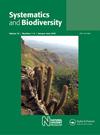Diversification of the Pristimantis conspicillatus group (Anura: Craugastoridae) within distinct neotropical areas throughout the Neogene
IF 2
3区 环境科学与生态学
Q2 BIODIVERSITY CONSERVATION
引用次数: 3
Abstract
Determining the relative importance of dispersal and vicariance events across neotropical regions is a major goal in biogeography. These events are thought to be related to important landscape changes, notably the transition of Amazonia toward its modern hydrological configuration ca. 10 million years ago. We investigated the spatio-temporal context of the diversification of one of the major lineages of Pristimantis, a widespread and large genus of direct-developing Neotropical frogs. We gathered a spatially and taxonomically extensive sampling of mitochondrial DNA sequences from 754 Pristimantis gr. conspicillatus specimens, which led to delimiting 75 Operational Taxonomic Units (OTUs). Complete mitogenomes of 35 of these OTUs were assembled and collated with two nuDNA loci to reconstruct a time-calibrated phylogeny. We identified five major clades that diverged around the Oligocene-Miocene transition and that are largely restricted to distinct Neotropical regions i.e. Western Amazonia (P. conspicillatus clade), the Brazilian Shield (P. fenestratus clade), the Atlantic Forest (P. ramagii clade), the Guiana Shield (P. vilarsi clade) and the northern Andes (P. nicefori clade). The majority of the diversification events within these clades occurred in-situ from the early Miocene onward. Yet, a few ancient dispersal/vicariance events are inferred to have occurred among trans-Andean forests, the Atlantic Forest, the Brazilian and the Guiana Shields, but almost none in the last 10 Ma. The radical landscape transformations during the Miocene caused by the Andean orogeny and hydrological barriers such as the Pebas System and the subsequent transcontinental configuration of the Amazon drainage is a likely explanation for the isolation of the different clades within the P. gr. conspicillatus.在整个新第三纪不同的新热带地区,普氏原螯虾群(Anura:螯虾科)的多样性
确定新热带地区扩散和迁移事件的相对重要性是生物地理学的一个主要目标。这些事件被认为与重要的景观变化有关,特别是大约1000万年前亚马逊河流域向现代水文形态的转变。我们研究了普氏蛙(Pristimantis)主要分支之一的时空多样性背景,普氏蛙是一种广泛分布的直接发育的新热带蛙属。本文对754份刺眼棱镜标本的线粒体DNA序列进行了广泛的空间和分类取样,划分出75个操作分类单元(otu)。对其中35个otu的完整有丝分裂基因组进行组装,并与两个nuDNA位点进行比对,以重建经过时间校准的系统发育。我们确定了在渐新世-中新世过渡期间分化的五个主要分支,这些分支主要局限于不同的新热带地区,即西亚马逊(P. illatus),巴西盾(P. fenestratus),大西洋森林(P. ramagii),圭亚那盾(P. vilarsi)和安第斯山脉北部(P. nicefori)。这些分支中的大部分多样化事件发生在中新世早期以后的原位。然而,据推测,在跨安第斯森林、大西洋森林、巴西森林和圭亚那森林中发生了一些古代的分散/迁移事件,但在过去的10万年里几乎没有发生。中新世期间,安第斯造山运动和水文屏障(如Pebas系统)以及随后的亚马逊流域横贯大陆的构造导致了剧烈的景观变化,这可能是P. gr. illatus内不同分支被隔离的一个解释。
本文章由计算机程序翻译,如有差异,请以英文原文为准。
求助全文
约1分钟内获得全文
求助全文
来源期刊

Systematics and Biodiversity
环境科学-生物多样性保护
CiteScore
4.10
自引率
0.00%
发文量
46
审稿时长
>24 weeks
期刊介绍:
Systematics and Biodiversity is devoted to whole-organism biology. It is a quarterly, international, peer-reviewed, life science journal, without page charges, which is published by Taylor & Francis for The Natural History Museum, London. The criterion for publication is scientific merit. Systematics and Biodiversity documents the diversity of organisms in all natural phyla, through taxonomic papers that have a broad context (not single species descriptions), while also addressing topical issues relating to biological collections, and the principles of systematics. It particularly emphasises the importance and multi-disciplinary significance of systematics, with contributions which address the implications of other fields for systematics, or which advance our understanding of other fields through taxonomic knowledge, especially in relation to the nature, origins, and conservation of biodiversity, at all taxonomic levels.
The journal does not publish single species descriptions, monographs or applied research nor alpha species descriptions. Taxonomic manuscripts must include modern methods such as cladistics or phylogenetic analysis.
 求助内容:
求助内容: 应助结果提醒方式:
应助结果提醒方式:


